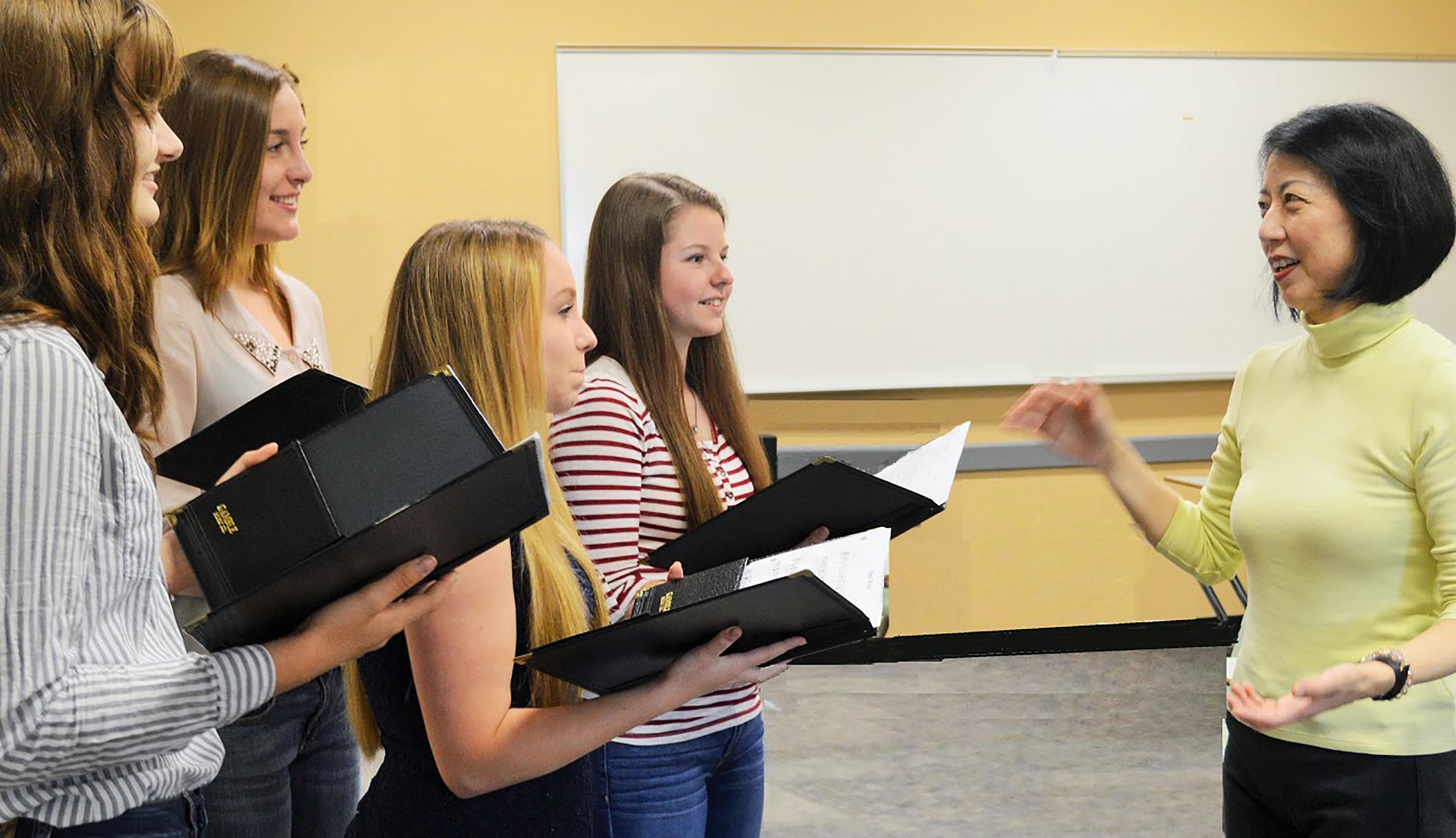Choral conservatory —Mihoko Tsutsumi (right), an internationally recognized conductor and member of SUNY Oswego’s music faculty, works with Oswego High School students as she prepares to direct the new Oswego Youth Conservatory. From left are sophomore Leah Mullen, senior Olivia Flint, junior Hannah Strzelinski and sophomore Leah Taylor. The first semester of the extracurricular vocal-training program, which is open to all Oswego County students from ages 12 to 18, will begin Sept. 8 and culminate in a holiday concert Dec. 1.
SUNY Oswego has begun assembling the first class for the new Oswego Youth Conservatory, reaching out to area schools by offering extracurricular training in choral singing to middle school, high school and home-schooled students ages 12 to 18.
Thanks to a startup grant of $26,000 from the Richard S. Shineman Foundation, music faculty member Robert Auler’s vision for offering college expertise and resources to supplement young students’ school music experiences will get underway Tuesday, Sept. 8.
Music faculty member Mihoko Tsutsumi, an internationally recognized choral conductor, will direct the Youth Conservatory, meeting with members from 4 to 5:30 p.m. each Tuesday in Room 101 of Lanigan Hall. The first semester will culminate in a gala holiday concert Dec. 1 in St. Mary’s Catholic Church on West Seventh Street in Oswego, as the Oswego Youth Conservatory joins the college’s State Singers, the College Choir and a group that long has welcomed adult members of the college and community, the Festival Chorus.
Julie Pretzat, dean of SUNY Oswego’s School of Communication, Media and the Arts, welcomed the Youth Conservatory as a project closely aligned with the college’s and school’s goal to use talent and other resources to raise up the community at large.
“This will give the students literacy skills—early literacy in music,” Pretzat said. “It’s more about training than just performing.”
The Youth Conservatory is open to students throughout Oswego County, Tsutsumi said. The cost per student is $196 a semester. The fee scale of $14 for each of 14 sessions per semester drops to $11 per session if an applicant joins with a sibling or friend and to $9 per session for those joining with two family members or friends.
Eventually, Auler said, the Oswego Youth Conservatory hopes to establish a scholarship fund to provide access to talented children from lower-income families.
‘Travel team’ experience
Tsutsumi said that among the essentials of choral singing she will teach or reinforce are note reading, diction, vocal exercises, aural response, blending and preparing with a purpose.
She and Auler emphasized that each applicant, unless home-schooled, needs to have permission of the leader of a school choral group that the student has joined, as well as a parent. “We want to be good neighbors to our colleagues working in area schools,” Auler said.
Pretzat likened the Youth Conservatory to a sports travel team, where students learn to excel with supplemental instruction and games. “This is community outreach, to provide students in the community with this level of expertise at a low cost and to provide a different type of activity than many students have an opportunity to take advantage of,” she said. “Some students simply can’t afford private lessons. This is about access.”
Auler’s idea for such a program came on a sabbatical during which he set out to study the delivery of music education in a variety of settings, from Barack Obama’s childhood school in Hawaii to large universities such as the University of Cincinnati, his and Pretzat’s alma mater. He saw how preparatory programs could serve communities and double as laboratories for college students who would one day become music teachers themselves.
Eventually, Auler said, he hopes the conservatory can expand to include instrumental musicians.
The Shineman Foundation grant through the college’s Office of Research and Sponsored Programs provided funds to hire a director, an administrative assistant and an accompanist, as well as to cover such startup costs as sheet music, promotion and other expenses.
Anyone interested in an application can visit oswego.edu/youth-conservatory or contact Pamela Lavallee at pamela.lavallee@oswego.edu or 315-245-7087. Potential sponsors for deserving students who could not otherwise afford the training are also encouraged to contact her.




